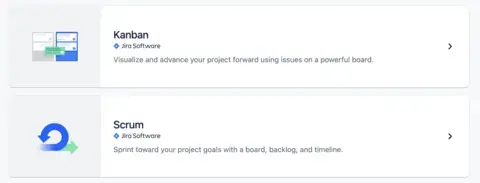Jira is a powerful tool for managing complex projects. When configured properly, it can help you organize your project and communicate with your team effectively. It also boasts automation features that save time and make everyone’s jobs easier. We’ve used it to run small, three-person projects and larger fourteen-person projects.
But Jira’s options and customizations can be overwhelming to new users. That’s to be expected. Powerful tools can look daunting to beginners, and the desire to slow down, take a step back, and get familiar with your surroundings is a good one. The more powerful the tool, the more you want to know what you’re doing before you turn the thing on and start waving it around.
This is the first in a series of articles on using Jira. Consider it a quick-start guide to using this powerful tool safely and effectively. We start with a crucial choice: selecting between Scrum and Kanban. When starting a new software project, Jira presents various template options, and this decision lays the foundation for your project, influencing every subsequent step, including the type of project you initiate in Jira. Which one should you choose?
Let’s examine the dynamics of Scrum and Kanban methodologies.
Commonalities
Each template has similarities worth noting. The issue types and workflows set up at the outset are the same, but they can be customized later on with different fields for the issue types and various workflow states if desired.
- Issue types: Epic, Story, Bug, Task, Sub-task
- Workflow: TO DO, IN PROGRESS, DONE
Scrum Boards: The Agile Marathon
In the realm of Scrum boards, think of your project as a series of sprints. Each sprint is a focused effort to complete a set of tasks, represented by a backlog. The Scrum board is your racetrack, guiding you from the starting line (To Do) to the finish line (Done), with clear checkpoints (statuses) along the way.
Scrum methodology suits projects with a clear start and end, like website migrations or builds. Effective sprint management involves planning ahead and ensuring only active sprint tickets are worked on. Label any added tickets correctly in Jira for accurate sprint reporting. Avoid common pitfalls like working on unscheduled tickets. While stakeholders often prefer Scrum for its structured approach, it's important to assess if it's the best method for each project rather than using it by default.
Kanban Boards: Continuous Flow
Kanban boards, on the other hand, are like a continuous flow of work, where tasks move smoothly from inception to completion. It’s less about the race and more about the journey. The Kanban board showcases tasks in various stages of completion, allowing for maximum flexibility and real-time tracking.
In a post-launch phase with continuous bug fixes, maintenance, and new features, a Kanban workflow is more efficient. It uses a just-in-time strategy with "Ready to Start" tickets, keeping work focused and manageable. Regular release cadences are beneficial for setting expectations and informing stakeholders through release reports. This approach reduces sprint planning overhead and avoids pitfalls like missing tickets or frequent mid-cycle sprint adjustments.
Why Not Both?
Larger projects can have part of the team working on a continuous flow of tickets (kanban style) and another part working on a large, new feature or initiative (scrum style). In this scenario, you could create two boards in Jira, one for each group. You can plan the initiative over time with a detailed structure while bug fixes and maintenance tasks are still cycled through.
The Kanban board could be the centralized board where the entire team’s work is visualized, and the Scrum board would be a subset of that, filtered to just the work in that initiative or epic. The team dedicated to the new feature can focus on the subset of work relevant to them and the PM or Scrum Master can accurately visualize and plan that set of work.
Playing to Win
Mastering Jira boards is about understanding the rules of the game and playing to your project's strengths. Whether you choose Scrum for its structured sprints or Kanban for its fluid workflow, the goal remains the same: to move tasks efficiently toward completion.
Whether you're sprinting with Scrum or flowing with Kanban, remember that Jira boards are powerful tools in the game of project management. Use them wisely, and watch your projects transform from a maze of tasks into a strategic, winning game plan.

